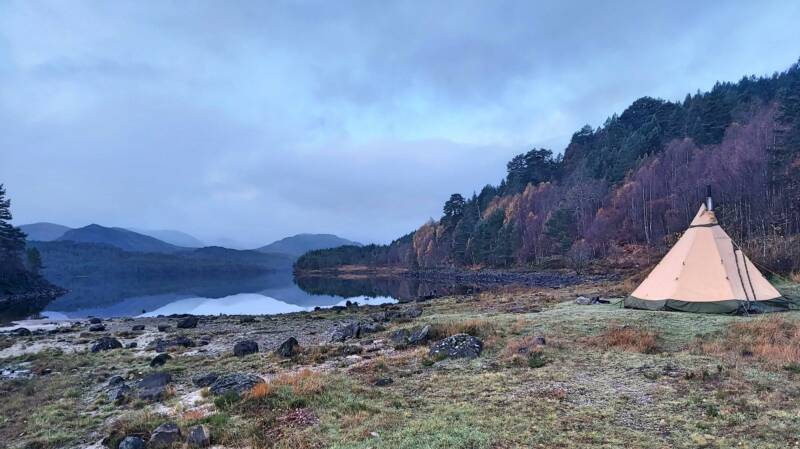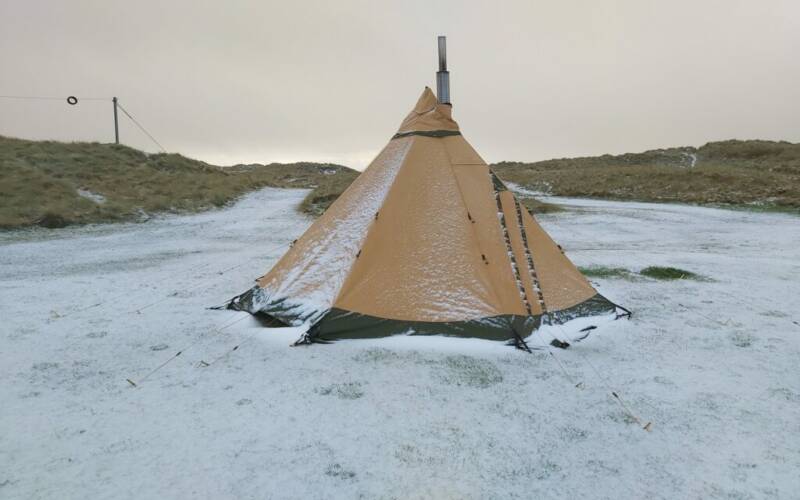
When the restrictions of the pandemic hit, outdoor author John D. Burns, could no longer visit the remote bothies that are his passion. John’s latest book, The Hot Tent Diaries, tells the story of his search for another way to experience wild places. A Hot Tent is simply a tent capable of being heated by a woodburning stove and for John they have opened up an exciting new way to explore our hills and glens.
It’s almost dark by the time I get the rest of my equipment into the tent and fix the storm guys in place. The tent feels a lot more solid now and the elements, for the most part, are kept outside. I’ve had to weigh down the tent’s skirt to prevent the wind from making its way underneath and lifting up the floor, but the tent now feels remarkably secure and the smell of new canvas takes me back to my first experience of camping in the old army tent my father borrowed. At last, I can settle back in my chair and light the old Tilley lamp I bought off eBay. The lamp pops when I try and start it, the result of air getting into the fuel pipe during transit. Seconds later it bursts into life and fills the tent with a warm glow and the gentle hiss of the burner. The tent is transformed instantly. Even though it is still cold, I feel secure in my canvas cocoon and can enjoy the sound of the hailstones being hurled against the tent in the wind.

Next is the step that fills me with most trepidation: lighting the stove. I have lit a great many fires in my time, so getting the thing alight does not worry me. It’s what happens next that concerns me. I sit, wondering if I have fitted the chimney correctly. If I haven’t got it right, will the tent ignite on my first attempt, leaving me very much the poorer and standing looking at a circle of smouldering canvas?
I’m on the campsite in Gairloch and the owner will be looking from her window, watching the flames leaping into the sky. I knew he was a lunatic.
I remind myself that thousands of people must have used a tent like this on countless nights, so the chimney must be insulated enough to protect the tent. With a leap of faith, I put a match to the kindling, close the metal door and hope. Once that wood is alight, there is no way back.

The stove crackles hungrily. From inside, I can hear a low roar as kindling and wood ignite. The stove has come alive, and it creaks and groans as the metal expands. I watch the chimney and the canvas aperture anxiously but, to my relief, there is no sign of anything burning. After two or three minutes, the stove is well alight and I can feel its heat radiating into the tent. I reason that if the tent was going to burn down, it would be alight by now. I can relax. I decide to put my duvet jacket on while I wait for the tent to get warm. When I stand up to reach my jacket, I realise that the tent is already warm. I’m used to bothies that take two or three hours to get comfortable. This tent is different; it has the major advantage of warming up pretty much instantly. This also means that I can heat the tent in the morning if I need to, which is something I’ve never done in a bothy. It’s impossible to carry enough fuel for a fire in the morning and bothies take so long to heat up that the fire would be a waste of time.
Slowly, as the night deepens across the campsite, the wind eases and the hailstorms cease. After my meal, I sit dozing beside the fire. It’s so warm that I am down to my tee shirt. In fact, it is almost too warm. Rising above me are cords that open the vents in the top of the tent. The problem is I have no idea how these vents operate, and I worry that if I pull the wrong cord then I might open a vent and not know how to close it. This threatens to expose me to a long, cold night. I decide I am safer to leave this complex system alone for tonight. I’ll investigate it tomorrow in the light of day.

The stove has been burning for two hours. If the tent was going to burn down, it would have done so by now. I can relax, confident in the knowledge that I’m unlikely to reduce my little shelter to ash in the near future. I finish reading my book and head out to my car to get another one. Unzipping the tent, I am greeted by a revelation. The wind has died completely and the great clouds that bore down on me so ominously while I was struggling to erect the tent have vanished, leaving a starlit sky glittering over an untroubled sea. Looking up, I see a dreamy vision of starlight and smoke.
Even more surprising than that, the rolling dunes of the campsite have been transformed. The grassy banks glitter with frost crystals in the beam of my head torch and my car is wreathed in ice. Sat in the confines of my tent, beside the wood-burning stove, I had been blissfully unaware of the plummeting temperatures. All that has separated me from this frozen world has been a thin canvas. This is proof positive that the tent can withstand sub-zero temperatures, hail and howling winds.
I have found my mobile bothy.
John Burn’s latest book The Hot Tent Diaries was published on 7th October and costs £10.99 in paperback via Amazon; it’s also available as an ebook. The book is not currently available via Bookshop.

